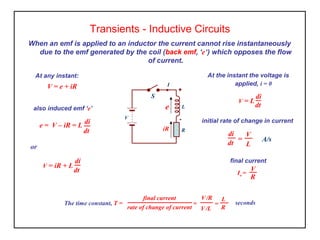
Elect principles 2 dc transients (inductive)
- 1. When an emf is applied to an inductor the current cannot rise instantaneously due to the emf generated by the coil (back emf, ‘e’) which opposes the flow of current. Transients - Inductive Circuits At the instant the voltage is applied, i = 0 At any instant: e iR - S V + R L I or V = e + iR also induced emf ‘e’ di dt e = V – iR = L = di dt V L A/s initial rate of change in current dt di V = L V = iR + L di dt final current Io = V R final current rate of change of current = L R seconds= V/L V/R The time constant, T =
- 2. As the current rises in an inductance, the back emf opposes the supply voltage and causes the rate of rise in current to reduce as time goes on. After approximately 5 time constants the current is within 1% of its maximum value. Transients - Inductive Circuits If the current continued to rise at its initial rate, it would reach its maximum value in one time constant (T) seconds. Initial rate of rise of current, di/dt = VS / L A/s Maximum current possible, I = VS / R A Current rise at any instant, i = I(1 – e – Rt /L ) V I=VS /R T ( L/R) 0 20 40 60 80 t (msec) 2.0 1.5 1.0 0.5 0 - S VS 100V + R = 50Ω L 800 mH I
- 3. If the source emf is removed and the inductor is short circuited the energy stored in the magnetic field will collapse. The current cannot fall immediately to zero as the collapse is opposed by the self induced emf which tries to maintain the current at its original value. Transients - Inductive Circuits After 5 time constants the current is said to have reached its final value although the equation allows for a continuously decaying state. Initial rate of decay of current, di/dt = -VL / L A/s Initial current possible, I = VL / R Current decay at any instant, i = Ie – Rt /L I=VS /R T ( L/R) 0 20 40 60 80 t (msec) 2.0 1.5 1.0 0.5 0 - + R = 50Ω L 800 mH I
- 4. Transients – Inductive Circuits Activity 1. A 200mH inductor is connected to a 20V dc supply. If the coil resistance is 10Ω, determine a) the time constant, b) the initial rate of increase in current, c) the time to reach a fully charged state and d) the current at t = L/R s. 2. A coil of inductance 0.5H and resistance 25Ω is suddenly connected to a 100V supply. Find a) the current after 5 seconds, b) the time at which vL = vR and c) the final steady state current. 3. A coil of resistance 20Ω and inductance 250mH is connected to a 40V dc supply and the current is allowed to reach its final steady state after which the supply is removed and the coil instantly short circuited. Calculate a) the initial rate of decrease of current and b) the current after L/R seconds and c) the time for the current to be reduced by 20%.
- 5. What Have We Learnt The time constant for a LR network is T = LR seconds and after 5LR seconds the capacitor is fully charged or discharged. The rate of change of current is continuously opposed by the induced emf (back emf) in the coil. 0 10 20 30 40 50 60 70 80 90 100 110 120 0 29 59 88 118 147 176 206 235 265 294 324 353 382 412 441 471 500 t i I 0 1 2 3 4 5 6 7 8 9 10 0 59 118 176 235 294 353 412 471 I t i The decaying current (i) at any instant in time can be found using the formula i = Io e – Rt /L The rising current (i) at any instant in time can be found using the formula i = Io (1 – e -R t /L )
- 6. What Have We Learnt The time constant for a LR network is T = LR seconds and after 5LR seconds the capacitor is fully charged or discharged. The rate of change of current is continuously opposed by the induced emf (back emf) in the coil. 0 10 20 30 40 50 60 70 80 90 100 110 120 0 29 59 88 118 147 176 206 235 265 294 324 353 382 412 441 471 500 t i I 0 1 2 3 4 5 6 7 8 9 10 0 59 118 176 235 294 353 412 471 I t i The decaying current (i) at any instant in time can be found using the formula i = Io e – Rt /L The rising current (i) at any instant in time can be found using the formula i = Io (1 – e -R t /L )